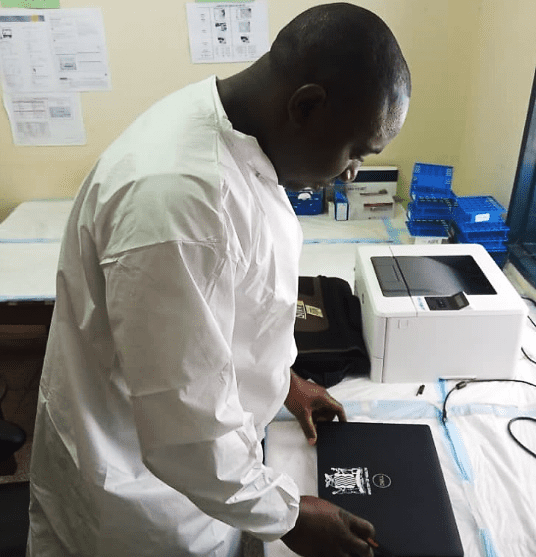Q & A: Making Data-driven Supply Chain Decisions
November 4th, 2021 | story
The USAID Electronic Supply Chain Management Information System (eSCMIS) project is improving information availability for supply chain managers at all levels, with funding from the United States Agency for International Development (USAID) and the U.S. President’s Emergency Plan for AIDS Relief (PEPFAR). The electronic logistics management system (eLMIS) Central Edition (CE) analytics and Facility Edition (FE) transaction data have helped end users make decisions that have improved supply chain efficiency.
The USAID eSCMIS project sat down with supply chain managers at various levels to learn how the system has helped them make data-driven decisions.

What is your name, occupation and location?
Hello, my name is Nalishebo Siyandi (pictured above), and I work for the Zambia Medicines and Medical Supplies Agency (ZAMMSA) in Lusaka as the call center manager.
How long have you been using the eLMIS?
I’ve been using the eLMIS since it was introduced in 2014; I’ve basically been there since the beginning.
How exactly do you use the eLMIS?
Orders are processed on a daily basis. We process orders that facilities send in through reports so that we can resupply. We also examine how the facilities have been reporting and ensure that we check for errors. For example, there are times when we receive reports that show what the facility requires but do not include actual quantities, so we contact these facilities to have them enter and submit this information.
We continually monitor facility data quality so we can ensure that the reports are of a high standard because this information promotes effective restocking.
Additionally, we keep an eye on reporting rates; we constantly monitor reporting to establish distribution schedules, so we keep an eye on non-reporting sites to ensure they report and are resupplied on time. The eLMIS is effective.
We also examine the system’s consumption data on a daily basis, in addition to processing orders and performing quality checks on reports. This information aids us in developing an allocation desk for the entire country. We can allocate products across the country by looking at the information submitted by province. For example, if we haven’t had a certain product in the country for six months and then it comes in, we can easily go back to the consumption data from when it stocked out and come up with allocations for redistribution across the country.
What stands out the most for you about how the eLMIS has evolved?
Since its inception, the eLMIS has progressed to the point that it is continuously making it easier to monitor facilities and do data analytics. As a customer service representative, it is critical to anticipate end-user needs, and the eLMIS helps us do that.
Being able to check the proportion of products that have been reported when orders are received has been extremely beneficial to my department. Because when the reports come in, we can look at the percentages of products ordered for specific locations and create trends based on the consumption statistics.
Also, being able to use the reports to determine which facilities in a given region have surplus stock has made it much easier for us to execute emergency requests because we can simply redistribute from one facility to another. Furthermore, looking at the information of facilities that are continuously placing emergency orders helps us determine why a given product is always stocked out and whether it has anything to do with how facilities are ordering.

What is your name, occupation and location?
Hello, my name is Payne Mungala, and I am a pharmacist at the provincial health office in Livingstone in the Southern Province.
How long have you been using the eLMIS?
I’ve been using the eLMIS since 2015.
How exactly do you use the eLMIS?
My daily routine has changed since I began using the eLMIS. When I worked at a facility, I used the FE, but now I use the CE to monitor facilities in my province. The most common decisions I make are reporting, which involves ensuring that facilities report on time and accurately. The reporting status data in CE also allows me to follow up with facilities that are having difficulty reporting so that I may offer support and determine how we can best assist them. I don’t have to travel from facility to facility in my province to observe what’s going on; I can keep an eye on things from my office.
On occasion, we discover that a facility has product stock about to expire or more stock than it can use in a given period of time. We quickly search the system for other facilities that require these products so that we can share them and ensure that they are used on time.
I also find myself looking at consumption data to see how the province is doing in terms of consumption. We also use consumption data for data quality checks; for example, if I compare a report to a facility’s stock status, I can assess if it is reporting appropriately based on accurate consumption averages.
What stands out the most for you about how the eLMIS has evolved?
The product batch and expiry tracking functionality in the eLMIS FE is one that jumps out. With this functionality, we can simply tell what batch of items traveled where, and we can track products not just at a provincial level, but also nationwide. Furthermore, regardless of when you entered the products, the system employs the first expiry, first out mechanism, which immediately identifies which products will expire first and should be transacted out first. This is one of the tools that has helped us reduce wastage due to expirations.

What is your name, occupation and location?
My name is Terrence Shibwela, and I work as a laboratory technician at Mongu District Hospital in Western Province.
How long have you been using the eLMIS?
I have been using the eLMIS since I was employed in 2017.
How exactly do you use the eLMIS?
We are definitely on the system daily because we use eLMIS FE for all of our storeroom transactions. In the lab, I’m always looking at our stock status cards to see what items are in short supply.
I can easily track product usage by checking stock levels in the storeroom and other locations such as our VCT center or lab bench.
I’m constantly looking at consumption data; it not only helps us calculate the average monthly consumption, but it also allows us to study trends and forecast how much of a particular product will be needed, as well as which lab commodities are consumed more frequently in different parts of the facility.
What stands out the most for you about how the eLMIS has evolved?
Before, when we submitted reports using eLMIS FE, someone had to go back and update them in CE because we couldn’t put in the requested quantities from FE when the system initially started. Because the entire report data is aggregated in FE, this has been a fantastic improvement. Another thing I’ve noticed is that in the past, the system was quite slow when sending reports since we had to synchronize. However, with the eLMIS FE web edition, it is much faster.
One last point that I can make is that before we updated to eLMIS FE web edition, we couldn’t see the status of our reports; we had to log into CE. Now we can see the report status, which includes whether or not it was submitted successfully and if it was approved.
Learn more about our work in Zambia.
We strive to build lasting relationships to produce better health outcomes for all.